Corporate and Financial Accounting: Takeover and Consolidation Report
VerifiedAdded on 2023/04/04
|11
|2780
|214
Report
AI Summary
This report delves into the core concepts of corporate and financial accounting, primarily focusing on business combinations and the application of equity and consolidation accounting methods. The report provides a clear distinction between asset acquisition and business combination, outlining the procedures and considerations required under AASB 3. It illustrates equity accounting, emphasizing significant influence and the treatment of investments in associates. The report further elucidates consolidation accounting, highlighting the parent-subsidiary relationship and the preparation of consolidated financial statements. It presents the differences between equity and consolidation accounting, and addresses the treatment of intra-group transactions, including profit allocation in upstream sales, and the principles relating to non-controlling interest (NCI) and disclosure requirements. Finally, the report discusses issues encountered in the consolidation process, particularly concerning the transition from equity to consolidation accounting, providing a thorough understanding of corporate accounting principles.

Running Head: Corporate and Financial Accounting
Corporate and Financial Accounting
Corporate and Financial Accounting
Paraphrase This Document
Need a fresh take? Get an instant paraphrase of this document with our AI Paraphraser

Corporate and Financial Accounting
Contents
Executive Summary.......................................................................................................................................2
Introduction.....................................................................................................................................................2
Equity Accounting and Consolidation Accounting.....................................................................................2
Equity Accounting......................................................................................................................................3
Consolidation Accounting.........................................................................................................................4
Difference between Equity Accounting and Consolidation Accounting..............................................5
Treatment of Intra-group Transactions and Profit Allocation...................................................................5
Disclosure requirements of Non-controlling Interest.................................................................................7
Issues in the Consolidation Process...........................................................................................................7
Conclusion......................................................................................................................................................9
References...................................................................................................................................................10
1
Contents
Executive Summary.......................................................................................................................................2
Introduction.....................................................................................................................................................2
Equity Accounting and Consolidation Accounting.....................................................................................2
Equity Accounting......................................................................................................................................3
Consolidation Accounting.........................................................................................................................4
Difference between Equity Accounting and Consolidation Accounting..............................................5
Treatment of Intra-group Transactions and Profit Allocation...................................................................5
Disclosure requirements of Non-controlling Interest.................................................................................7
Issues in the Consolidation Process...........................................................................................................7
Conclusion......................................................................................................................................................9
References...................................................................................................................................................10
1
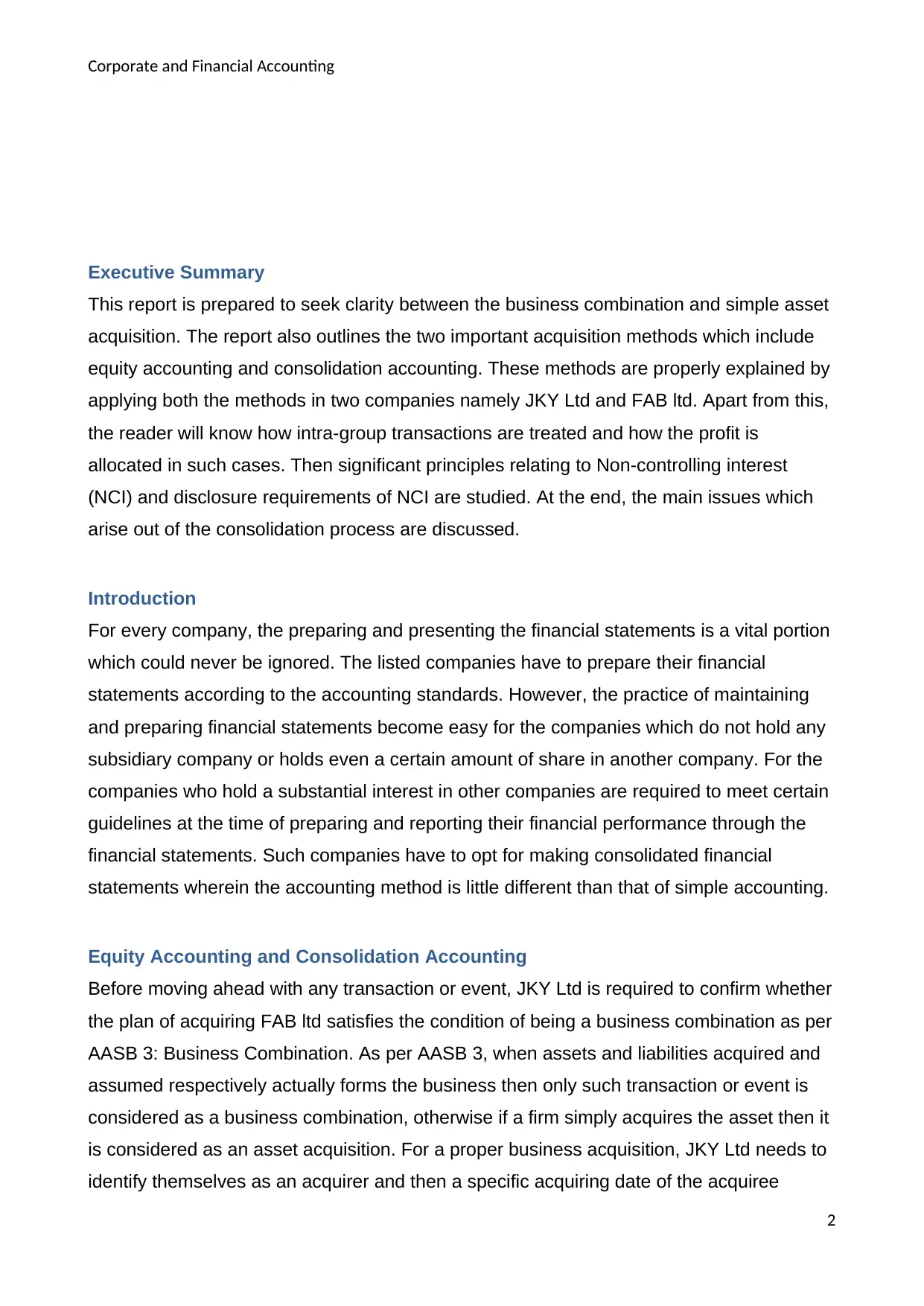
Corporate and Financial Accounting
Executive Summary
This report is prepared to seek clarity between the business combination and simple asset
acquisition. The report also outlines the two important acquisition methods which include
equity accounting and consolidation accounting. These methods are properly explained by
applying both the methods in two companies namely JKY Ltd and FAB ltd. Apart from this,
the reader will know how intra-group transactions are treated and how the profit is
allocated in such cases. Then significant principles relating to Non-controlling interest
(NCI) and disclosure requirements of NCI are studied. At the end, the main issues which
arise out of the consolidation process are discussed.
Introduction
For every company, the preparing and presenting the financial statements is a vital portion
which could never be ignored. The listed companies have to prepare their financial
statements according to the accounting standards. However, the practice of maintaining
and preparing financial statements become easy for the companies which do not hold any
subsidiary company or holds even a certain amount of share in another company. For the
companies who hold a substantial interest in other companies are required to meet certain
guidelines at the time of preparing and reporting their financial performance through the
financial statements. Such companies have to opt for making consolidated financial
statements wherein the accounting method is little different than that of simple accounting.
Equity Accounting and Consolidation Accounting
Before moving ahead with any transaction or event, JKY Ltd is required to confirm whether
the plan of acquiring FAB ltd satisfies the condition of being a business combination as per
AASB 3: Business Combination. As per AASB 3, when assets and liabilities acquired and
assumed respectively actually forms the business then only such transaction or event is
considered as a business combination, otherwise if a firm simply acquires the asset then it
is considered as an asset acquisition. For a proper business acquisition, JKY Ltd needs to
identify themselves as an acquirer and then a specific acquiring date of the acquiree
2
Executive Summary
This report is prepared to seek clarity between the business combination and simple asset
acquisition. The report also outlines the two important acquisition methods which include
equity accounting and consolidation accounting. These methods are properly explained by
applying both the methods in two companies namely JKY Ltd and FAB ltd. Apart from this,
the reader will know how intra-group transactions are treated and how the profit is
allocated in such cases. Then significant principles relating to Non-controlling interest
(NCI) and disclosure requirements of NCI are studied. At the end, the main issues which
arise out of the consolidation process are discussed.
Introduction
For every company, the preparing and presenting the financial statements is a vital portion
which could never be ignored. The listed companies have to prepare their financial
statements according to the accounting standards. However, the practice of maintaining
and preparing financial statements become easy for the companies which do not hold any
subsidiary company or holds even a certain amount of share in another company. For the
companies who hold a substantial interest in other companies are required to meet certain
guidelines at the time of preparing and reporting their financial performance through the
financial statements. Such companies have to opt for making consolidated financial
statements wherein the accounting method is little different than that of simple accounting.
Equity Accounting and Consolidation Accounting
Before moving ahead with any transaction or event, JKY Ltd is required to confirm whether
the plan of acquiring FAB ltd satisfies the condition of being a business combination as per
AASB 3: Business Combination. As per AASB 3, when assets and liabilities acquired and
assumed respectively actually forms the business then only such transaction or event is
considered as a business combination, otherwise if a firm simply acquires the asset then it
is considered as an asset acquisition. For a proper business acquisition, JKY Ltd needs to
identify themselves as an acquirer and then a specific acquiring date of the acquiree
2
⊘ This is a preview!⊘
Do you want full access?
Subscribe today to unlock all pages.

Trusted by 1+ million students worldwide

Corporate and Financial Accounting
needs to be determined by the JKY Ltd (acquirer). On the date of acquisition all the assets,
liabilities and other non-controlling interest in the acquiree (FABLtd.) are need to be
recognised however, goodwill is not required to be recognised. At last goodwill or gain
earned from the bargain purchase must be recognised. Goodwill amount is recognised
when the sum of consideration transferred, the amount relating to acquiree’s non-
controlling interest and the business combination realized in phases exceed the
recognised amount on the acquisition date of the acquired identifiable assets and liabilities
assumed and vice-versa in case of bargain purchase (AASB 3, 2015).
There are usually two preferably methods of accounting:
Equity Accounting
There are two parties involved in case of equity accounting one is the investor and the
other is investee. There is no relationship of parent and subsidiary company. Here, the
investor does not have a complete control over the investee rather it has just a significant
influence over it. Equity accounting has the tendency of improving profitability margin and
return on assets (So, Wong, Zhang and Zhang, 2018). As per AASB 128, in case of
significant influence the investor could participate in the decisions of investee relating to
operating and financial policies however, he is neither a part of control nor joint control of
those particular policies. When an entity has 20% or more shares or voting rights of the
investee, it is deemed that the entity is having a significant influence over the investee
(AASB 128, 2016).
For Example, JKY Ltd purchased 30% of FAB Ltd. for $500,000. At the year end, FAB Ltd.
earned a net income of $100,000. Also, dividend of $50,000 for their shareholders.
When JKY Ltd carried out the purchase, investment was recorded under “Investments in
Associates”, a long-term asset account. The transaction recorded was at cost price.
JKY Ltd got dividends of $15,000 (30% of $50,000) and in their investment account a
reduction was recorded because the money from the investee was received. Simply, the
investment account was reduced because of cash outflow from the investee.
Finally, the net income received from FAB Ltd was recorded by JKY Ltd as an increase in
the Investment account.
3
needs to be determined by the JKY Ltd (acquirer). On the date of acquisition all the assets,
liabilities and other non-controlling interest in the acquiree (FABLtd.) are need to be
recognised however, goodwill is not required to be recognised. At last goodwill or gain
earned from the bargain purchase must be recognised. Goodwill amount is recognised
when the sum of consideration transferred, the amount relating to acquiree’s non-
controlling interest and the business combination realized in phases exceed the
recognised amount on the acquisition date of the acquired identifiable assets and liabilities
assumed and vice-versa in case of bargain purchase (AASB 3, 2015).
There are usually two preferably methods of accounting:
Equity Accounting
There are two parties involved in case of equity accounting one is the investor and the
other is investee. There is no relationship of parent and subsidiary company. Here, the
investor does not have a complete control over the investee rather it has just a significant
influence over it. Equity accounting has the tendency of improving profitability margin and
return on assets (So, Wong, Zhang and Zhang, 2018). As per AASB 128, in case of
significant influence the investor could participate in the decisions of investee relating to
operating and financial policies however, he is neither a part of control nor joint control of
those particular policies. When an entity has 20% or more shares or voting rights of the
investee, it is deemed that the entity is having a significant influence over the investee
(AASB 128, 2016).
For Example, JKY Ltd purchased 30% of FAB Ltd. for $500,000. At the year end, FAB Ltd.
earned a net income of $100,000. Also, dividend of $50,000 for their shareholders.
When JKY Ltd carried out the purchase, investment was recorded under “Investments in
Associates”, a long-term asset account. The transaction recorded was at cost price.
JKY Ltd got dividends of $15,000 (30% of $50,000) and in their investment account a
reduction was recorded because the money from the investee was received. Simply, the
investment account was reduced because of cash outflow from the investee.
Finally, the net income received from FAB Ltd was recorded by JKY Ltd as an increase in
the Investment account.
3
Paraphrase This Document
Need a fresh take? Get an instant paraphrase of this document with our AI Paraphraser
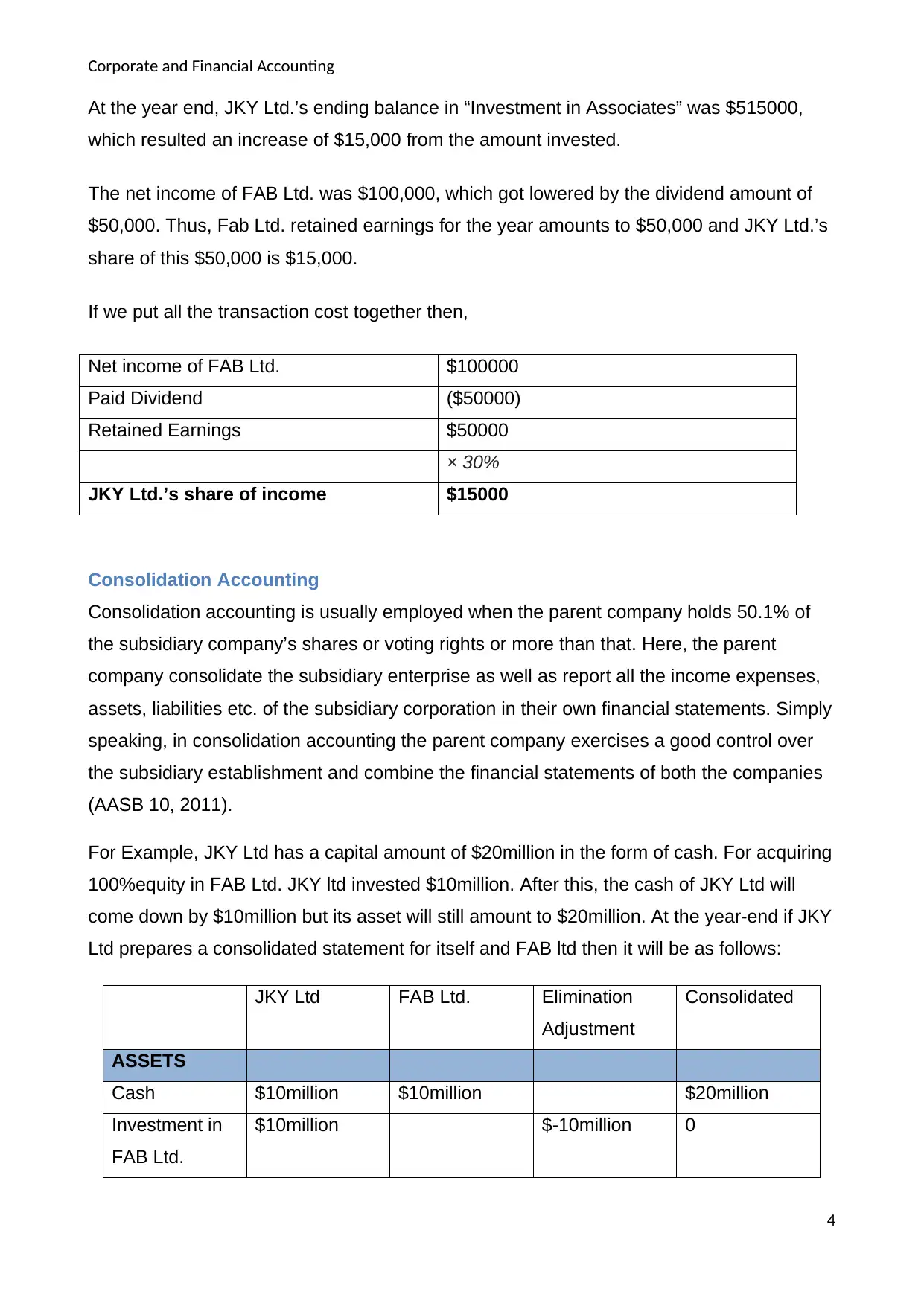
Corporate and Financial Accounting
At the year end, JKY Ltd.’s ending balance in “Investment in Associates” was $515000,
which resulted an increase of $15,000 from the amount invested.
The net income of FAB Ltd. was $100,000, which got lowered by the dividend amount of
$50,000. Thus, Fab Ltd. retained earnings for the year amounts to $50,000 and JKY Ltd.’s
share of this $50,000 is $15,000.
If we put all the transaction cost together then,
Net income of FAB Ltd. $100000
Paid Dividend ($50000)
Retained Earnings $50000
× 30%
JKY Ltd.’s share of income $15000
Consolidation Accounting
Consolidation accounting is usually employed when the parent company holds 50.1% of
the subsidiary company’s shares or voting rights or more than that. Here, the parent
company consolidate the subsidiary enterprise as well as report all the income expenses,
assets, liabilities etc. of the subsidiary corporation in their own financial statements. Simply
speaking, in consolidation accounting the parent company exercises a good control over
the subsidiary establishment and combine the financial statements of both the companies
(AASB 10, 2011).
For Example, JKY Ltd has a capital amount of $20million in the form of cash. For acquiring
100%equity in FAB Ltd. JKY ltd invested $10million. After this, the cash of JKY Ltd will
come down by $10million but its asset will still amount to $20million. At the year-end if JKY
Ltd prepares a consolidated statement for itself and FAB ltd then it will be as follows:
JKY Ltd FAB Ltd. Elimination
Adjustment
Consolidated
ASSETS
Cash $10million $10million $20million
Investment in
FAB Ltd.
$10million $-10million 0
4
At the year end, JKY Ltd.’s ending balance in “Investment in Associates” was $515000,
which resulted an increase of $15,000 from the amount invested.
The net income of FAB Ltd. was $100,000, which got lowered by the dividend amount of
$50,000. Thus, Fab Ltd. retained earnings for the year amounts to $50,000 and JKY Ltd.’s
share of this $50,000 is $15,000.
If we put all the transaction cost together then,
Net income of FAB Ltd. $100000
Paid Dividend ($50000)
Retained Earnings $50000
× 30%
JKY Ltd.’s share of income $15000
Consolidation Accounting
Consolidation accounting is usually employed when the parent company holds 50.1% of
the subsidiary company’s shares or voting rights or more than that. Here, the parent
company consolidate the subsidiary enterprise as well as report all the income expenses,
assets, liabilities etc. of the subsidiary corporation in their own financial statements. Simply
speaking, in consolidation accounting the parent company exercises a good control over
the subsidiary establishment and combine the financial statements of both the companies
(AASB 10, 2011).
For Example, JKY Ltd has a capital amount of $20million in the form of cash. For acquiring
100%equity in FAB Ltd. JKY ltd invested $10million. After this, the cash of JKY Ltd will
come down by $10million but its asset will still amount to $20million. At the year-end if JKY
Ltd prepares a consolidated statement for itself and FAB ltd then it will be as follows:
JKY Ltd FAB Ltd. Elimination
Adjustment
Consolidated
ASSETS
Cash $10million $10million $20million
Investment in
FAB Ltd.
$10million $-10million 0
4
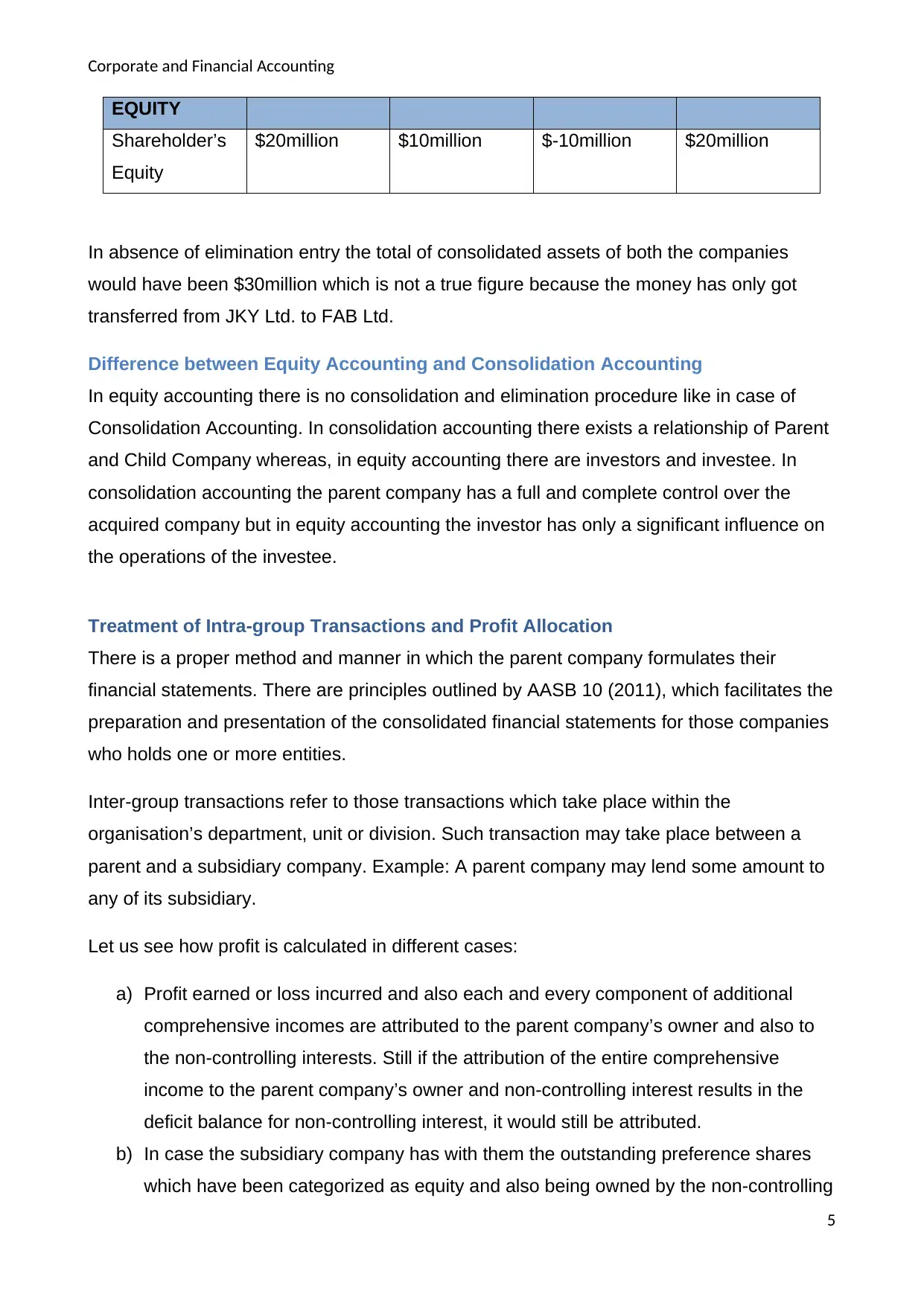
Corporate and Financial Accounting
EQUITY
Shareholder’s
Equity
$20million $10million $-10million $20million
In absence of elimination entry the total of consolidated assets of both the companies
would have been $30million which is not a true figure because the money has only got
transferred from JKY Ltd. to FAB Ltd.
Difference between Equity Accounting and Consolidation Accounting
In equity accounting there is no consolidation and elimination procedure like in case of
Consolidation Accounting. In consolidation accounting there exists a relationship of Parent
and Child Company whereas, in equity accounting there are investors and investee. In
consolidation accounting the parent company has a full and complete control over the
acquired company but in equity accounting the investor has only a significant influence on
the operations of the investee.
Treatment of Intra-group Transactions and Profit Allocation
There is a proper method and manner in which the parent company formulates their
financial statements. There are principles outlined by AASB 10 (2011), which facilitates the
preparation and presentation of the consolidated financial statements for those companies
who holds one or more entities.
Inter-group transactions refer to those transactions which take place within the
organisation’s department, unit or division. Such transaction may take place between a
parent and a subsidiary company. Example: A parent company may lend some amount to
any of its subsidiary.
Let us see how profit is calculated in different cases:
a) Profit earned or loss incurred and also each and every component of additional
comprehensive incomes are attributed to the parent company’s owner and also to
the non-controlling interests. Still if the attribution of the entire comprehensive
income to the parent company’s owner and non-controlling interest results in the
deficit balance for non-controlling interest, it would still be attributed.
b) In case the subsidiary company has with them the outstanding preference shares
which have been categorized as equity and also being owned by the non-controlling
5
EQUITY
Shareholder’s
Equity
$20million $10million $-10million $20million
In absence of elimination entry the total of consolidated assets of both the companies
would have been $30million which is not a true figure because the money has only got
transferred from JKY Ltd. to FAB Ltd.
Difference between Equity Accounting and Consolidation Accounting
In equity accounting there is no consolidation and elimination procedure like in case of
Consolidation Accounting. In consolidation accounting there exists a relationship of Parent
and Child Company whereas, in equity accounting there are investors and investee. In
consolidation accounting the parent company has a full and complete control over the
acquired company but in equity accounting the investor has only a significant influence on
the operations of the investee.
Treatment of Intra-group Transactions and Profit Allocation
There is a proper method and manner in which the parent company formulates their
financial statements. There are principles outlined by AASB 10 (2011), which facilitates the
preparation and presentation of the consolidated financial statements for those companies
who holds one or more entities.
Inter-group transactions refer to those transactions which take place within the
organisation’s department, unit or division. Such transaction may take place between a
parent and a subsidiary company. Example: A parent company may lend some amount to
any of its subsidiary.
Let us see how profit is calculated in different cases:
a) Profit earned or loss incurred and also each and every component of additional
comprehensive incomes are attributed to the parent company’s owner and also to
the non-controlling interests. Still if the attribution of the entire comprehensive
income to the parent company’s owner and non-controlling interest results in the
deficit balance for non-controlling interest, it would still be attributed.
b) In case the subsidiary company has with them the outstanding preference shares
which have been categorized as equity and also being owned by the non-controlling
5
⊘ This is a preview!⊘
Do you want full access?
Subscribe today to unlock all pages.

Trusted by 1+ million students worldwide
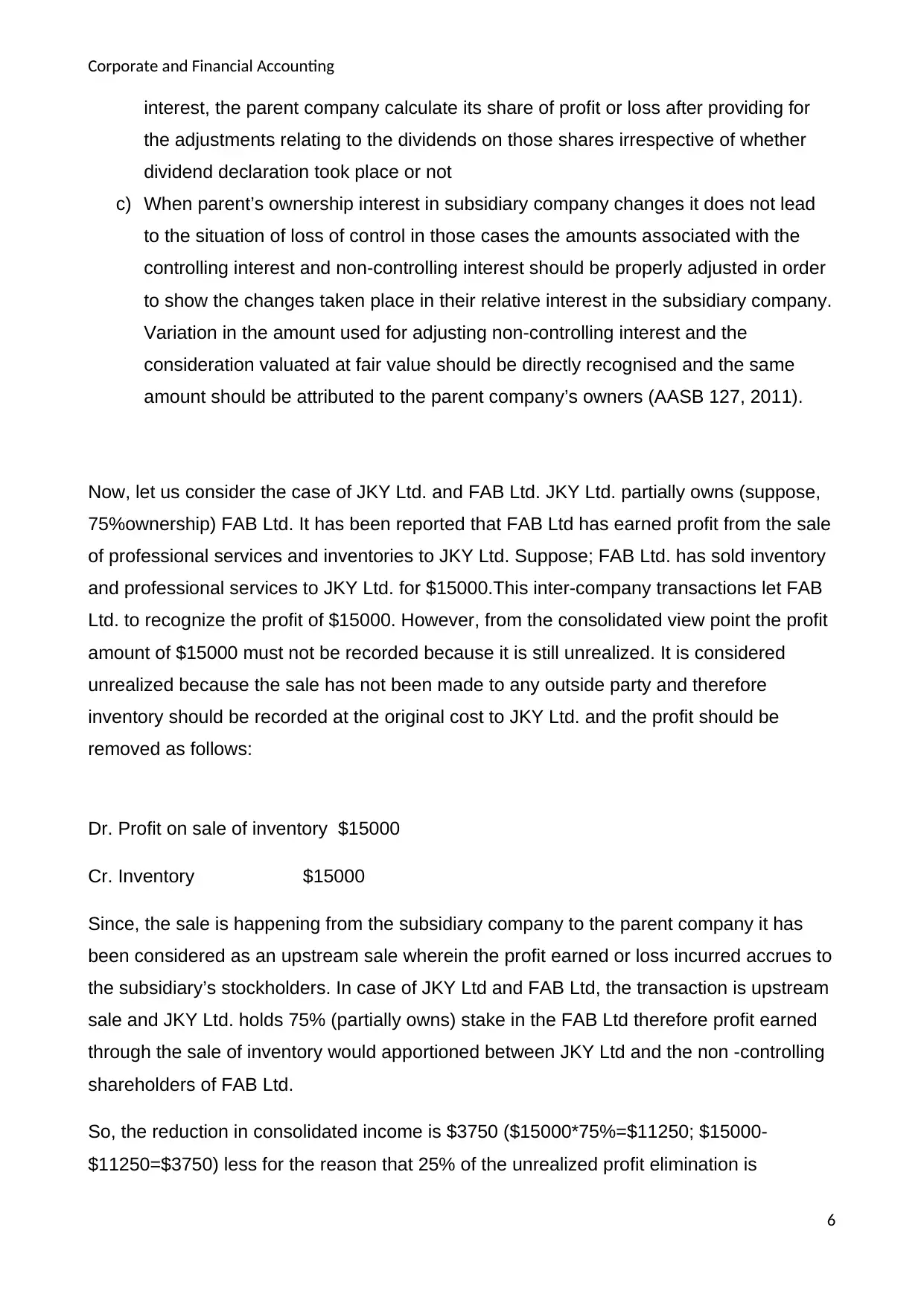
Corporate and Financial Accounting
interest, the parent company calculate its share of profit or loss after providing for
the adjustments relating to the dividends on those shares irrespective of whether
dividend declaration took place or not
c) When parent’s ownership interest in subsidiary company changes it does not lead
to the situation of loss of control in those cases the amounts associated with the
controlling interest and non-controlling interest should be properly adjusted in order
to show the changes taken place in their relative interest in the subsidiary company.
Variation in the amount used for adjusting non-controlling interest and the
consideration valuated at fair value should be directly recognised and the same
amount should be attributed to the parent company’s owners (AASB 127, 2011).
Now, let us consider the case of JKY Ltd. and FAB Ltd. JKY Ltd. partially owns (suppose,
75%ownership) FAB Ltd. It has been reported that FAB Ltd has earned profit from the sale
of professional services and inventories to JKY Ltd. Suppose; FAB Ltd. has sold inventory
and professional services to JKY Ltd. for $15000.This inter-company transactions let FAB
Ltd. to recognize the profit of $15000. However, from the consolidated view point the profit
amount of $15000 must not be recorded because it is still unrealized. It is considered
unrealized because the sale has not been made to any outside party and therefore
inventory should be recorded at the original cost to JKY Ltd. and the profit should be
removed as follows:
Dr. Profit on sale of inventory $15000
Cr. Inventory $15000
Since, the sale is happening from the subsidiary company to the parent company it has
been considered as an upstream sale wherein the profit earned or loss incurred accrues to
the subsidiary’s stockholders. In case of JKY Ltd and FAB Ltd, the transaction is upstream
sale and JKY Ltd. holds 75% (partially owns) stake in the FAB Ltd therefore profit earned
through the sale of inventory would apportioned between JKY Ltd and the non -controlling
shareholders of FAB Ltd.
So, the reduction in consolidated income is $3750 ($15000*75%=$11250; $15000-
$11250=$3750) less for the reason that 25% of the unrealized profit elimination is
6
interest, the parent company calculate its share of profit or loss after providing for
the adjustments relating to the dividends on those shares irrespective of whether
dividend declaration took place or not
c) When parent’s ownership interest in subsidiary company changes it does not lead
to the situation of loss of control in those cases the amounts associated with the
controlling interest and non-controlling interest should be properly adjusted in order
to show the changes taken place in their relative interest in the subsidiary company.
Variation in the amount used for adjusting non-controlling interest and the
consideration valuated at fair value should be directly recognised and the same
amount should be attributed to the parent company’s owners (AASB 127, 2011).
Now, let us consider the case of JKY Ltd. and FAB Ltd. JKY Ltd. partially owns (suppose,
75%ownership) FAB Ltd. It has been reported that FAB Ltd has earned profit from the sale
of professional services and inventories to JKY Ltd. Suppose; FAB Ltd. has sold inventory
and professional services to JKY Ltd. for $15000.This inter-company transactions let FAB
Ltd. to recognize the profit of $15000. However, from the consolidated view point the profit
amount of $15000 must not be recorded because it is still unrealized. It is considered
unrealized because the sale has not been made to any outside party and therefore
inventory should be recorded at the original cost to JKY Ltd. and the profit should be
removed as follows:
Dr. Profit on sale of inventory $15000
Cr. Inventory $15000
Since, the sale is happening from the subsidiary company to the parent company it has
been considered as an upstream sale wherein the profit earned or loss incurred accrues to
the subsidiary’s stockholders. In case of JKY Ltd and FAB Ltd, the transaction is upstream
sale and JKY Ltd. holds 75% (partially owns) stake in the FAB Ltd therefore profit earned
through the sale of inventory would apportioned between JKY Ltd and the non -controlling
shareholders of FAB Ltd.
So, the reduction in consolidated income is $3750 ($15000*75%=$11250; $15000-
$11250=$3750) less for the reason that 25% of the unrealized profit elimination is
6
Paraphrase This Document
Need a fresh take? Get an instant paraphrase of this document with our AI Paraphraser
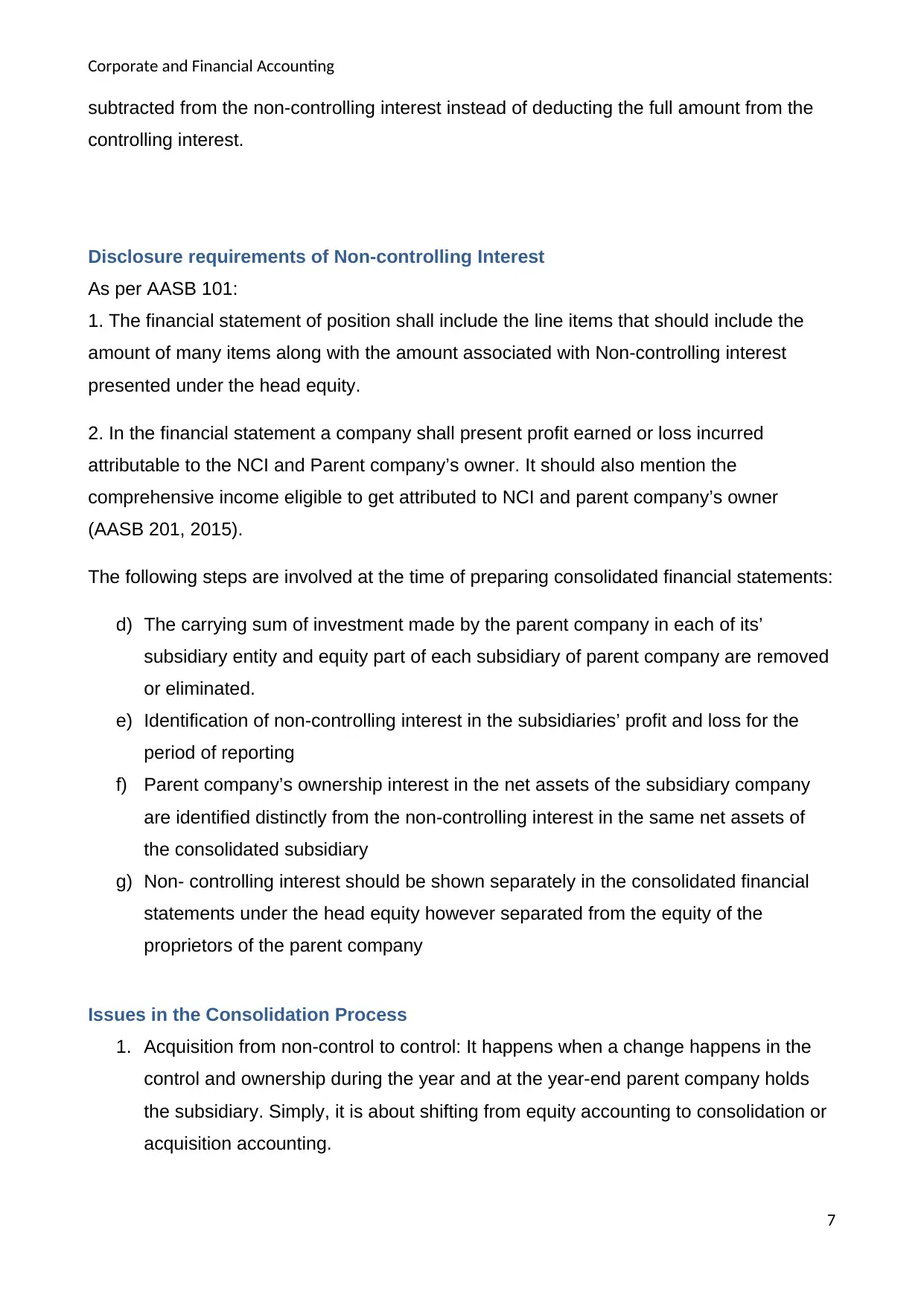
Corporate and Financial Accounting
subtracted from the non-controlling interest instead of deducting the full amount from the
controlling interest.
Disclosure requirements of Non-controlling Interest
As per AASB 101:
1. The financial statement of position shall include the line items that should include the
amount of many items along with the amount associated with Non-controlling interest
presented under the head equity.
2. In the financial statement a company shall present profit earned or loss incurred
attributable to the NCI and Parent company’s owner. It should also mention the
comprehensive income eligible to get attributed to NCI and parent company’s owner
(AASB 201, 2015).
The following steps are involved at the time of preparing consolidated financial statements:
d) The carrying sum of investment made by the parent company in each of its’
subsidiary entity and equity part of each subsidiary of parent company are removed
or eliminated.
e) Identification of non-controlling interest in the subsidiaries’ profit and loss for the
period of reporting
f) Parent company’s ownership interest in the net assets of the subsidiary company
are identified distinctly from the non-controlling interest in the same net assets of
the consolidated subsidiary
g) Non- controlling interest should be shown separately in the consolidated financial
statements under the head equity however separated from the equity of the
proprietors of the parent company
Issues in the Consolidation Process
1. Acquisition from non-control to control: It happens when a change happens in the
control and ownership during the year and at the year-end parent company holds
the subsidiary. Simply, it is about shifting from equity accounting to consolidation or
acquisition accounting.
7
subtracted from the non-controlling interest instead of deducting the full amount from the
controlling interest.
Disclosure requirements of Non-controlling Interest
As per AASB 101:
1. The financial statement of position shall include the line items that should include the
amount of many items along with the amount associated with Non-controlling interest
presented under the head equity.
2. In the financial statement a company shall present profit earned or loss incurred
attributable to the NCI and Parent company’s owner. It should also mention the
comprehensive income eligible to get attributed to NCI and parent company’s owner
(AASB 201, 2015).
The following steps are involved at the time of preparing consolidated financial statements:
d) The carrying sum of investment made by the parent company in each of its’
subsidiary entity and equity part of each subsidiary of parent company are removed
or eliminated.
e) Identification of non-controlling interest in the subsidiaries’ profit and loss for the
period of reporting
f) Parent company’s ownership interest in the net assets of the subsidiary company
are identified distinctly from the non-controlling interest in the same net assets of
the consolidated subsidiary
g) Non- controlling interest should be shown separately in the consolidated financial
statements under the head equity however separated from the equity of the
proprietors of the parent company
Issues in the Consolidation Process
1. Acquisition from non-control to control: It happens when a change happens in the
control and ownership during the year and at the year-end parent company holds
the subsidiary. Simply, it is about shifting from equity accounting to consolidation or
acquisition accounting.
7
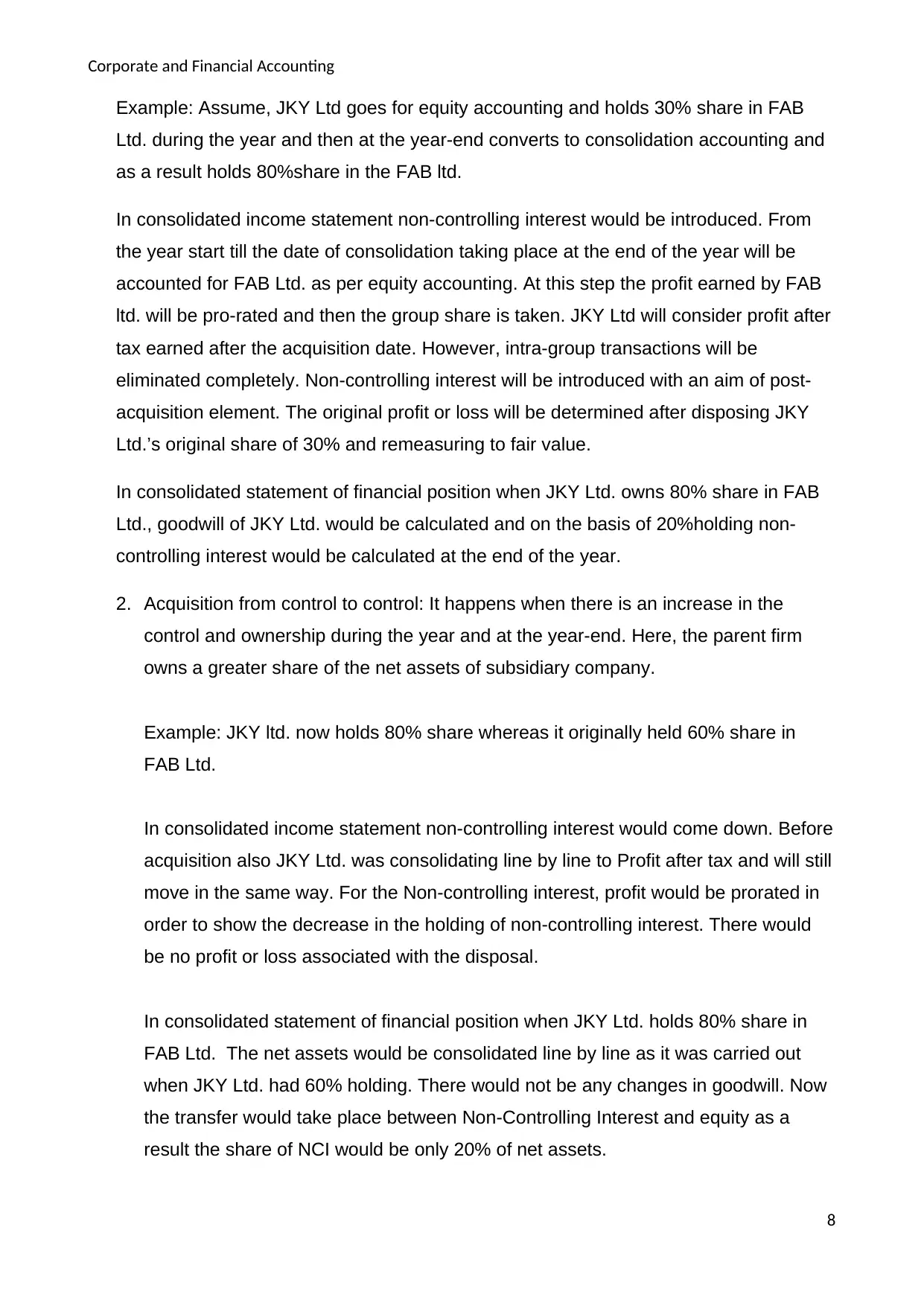
Corporate and Financial Accounting
Example: Assume, JKY Ltd goes for equity accounting and holds 30% share in FAB
Ltd. during the year and then at the year-end converts to consolidation accounting and
as a result holds 80%share in the FAB ltd.
In consolidated income statement non-controlling interest would be introduced. From
the year start till the date of consolidation taking place at the end of the year will be
accounted for FAB Ltd. as per equity accounting. At this step the profit earned by FAB
ltd. will be pro-rated and then the group share is taken. JKY Ltd will consider profit after
tax earned after the acquisition date. However, intra-group transactions will be
eliminated completely. Non-controlling interest will be introduced with an aim of post-
acquisition element. The original profit or loss will be determined after disposing JKY
Ltd.’s original share of 30% and remeasuring to fair value.
In consolidated statement of financial position when JKY Ltd. owns 80% share in FAB
Ltd., goodwill of JKY Ltd. would be calculated and on the basis of 20%holding non-
controlling interest would be calculated at the end of the year.
2. Acquisition from control to control: It happens when there is an increase in the
control and ownership during the year and at the year-end. Here, the parent firm
owns a greater share of the net assets of subsidiary company.
Example: JKY ltd. now holds 80% share whereas it originally held 60% share in
FAB Ltd.
In consolidated income statement non-controlling interest would come down. Before
acquisition also JKY Ltd. was consolidating line by line to Profit after tax and will still
move in the same way. For the Non-controlling interest, profit would be prorated in
order to show the decrease in the holding of non-controlling interest. There would
be no profit or loss associated with the disposal.
In consolidated statement of financial position when JKY Ltd. holds 80% share in
FAB Ltd. The net assets would be consolidated line by line as it was carried out
when JKY Ltd. had 60% holding. There would not be any changes in goodwill. Now
the transfer would take place between Non-Controlling Interest and equity as a
result the share of NCI would be only 20% of net assets.
8
Example: Assume, JKY Ltd goes for equity accounting and holds 30% share in FAB
Ltd. during the year and then at the year-end converts to consolidation accounting and
as a result holds 80%share in the FAB ltd.
In consolidated income statement non-controlling interest would be introduced. From
the year start till the date of consolidation taking place at the end of the year will be
accounted for FAB Ltd. as per equity accounting. At this step the profit earned by FAB
ltd. will be pro-rated and then the group share is taken. JKY Ltd will consider profit after
tax earned after the acquisition date. However, intra-group transactions will be
eliminated completely. Non-controlling interest will be introduced with an aim of post-
acquisition element. The original profit or loss will be determined after disposing JKY
Ltd.’s original share of 30% and remeasuring to fair value.
In consolidated statement of financial position when JKY Ltd. owns 80% share in FAB
Ltd., goodwill of JKY Ltd. would be calculated and on the basis of 20%holding non-
controlling interest would be calculated at the end of the year.
2. Acquisition from control to control: It happens when there is an increase in the
control and ownership during the year and at the year-end. Here, the parent firm
owns a greater share of the net assets of subsidiary company.
Example: JKY ltd. now holds 80% share whereas it originally held 60% share in
FAB Ltd.
In consolidated income statement non-controlling interest would come down. Before
acquisition also JKY Ltd. was consolidating line by line to Profit after tax and will still
move in the same way. For the Non-controlling interest, profit would be prorated in
order to show the decrease in the holding of non-controlling interest. There would
be no profit or loss associated with the disposal.
In consolidated statement of financial position when JKY Ltd. holds 80% share in
FAB Ltd. The net assets would be consolidated line by line as it was carried out
when JKY Ltd. had 60% holding. There would not be any changes in goodwill. Now
the transfer would take place between Non-Controlling Interest and equity as a
result the share of NCI would be only 20% of net assets.
8
⊘ This is a preview!⊘
Do you want full access?
Subscribe today to unlock all pages.

Trusted by 1+ million students worldwide
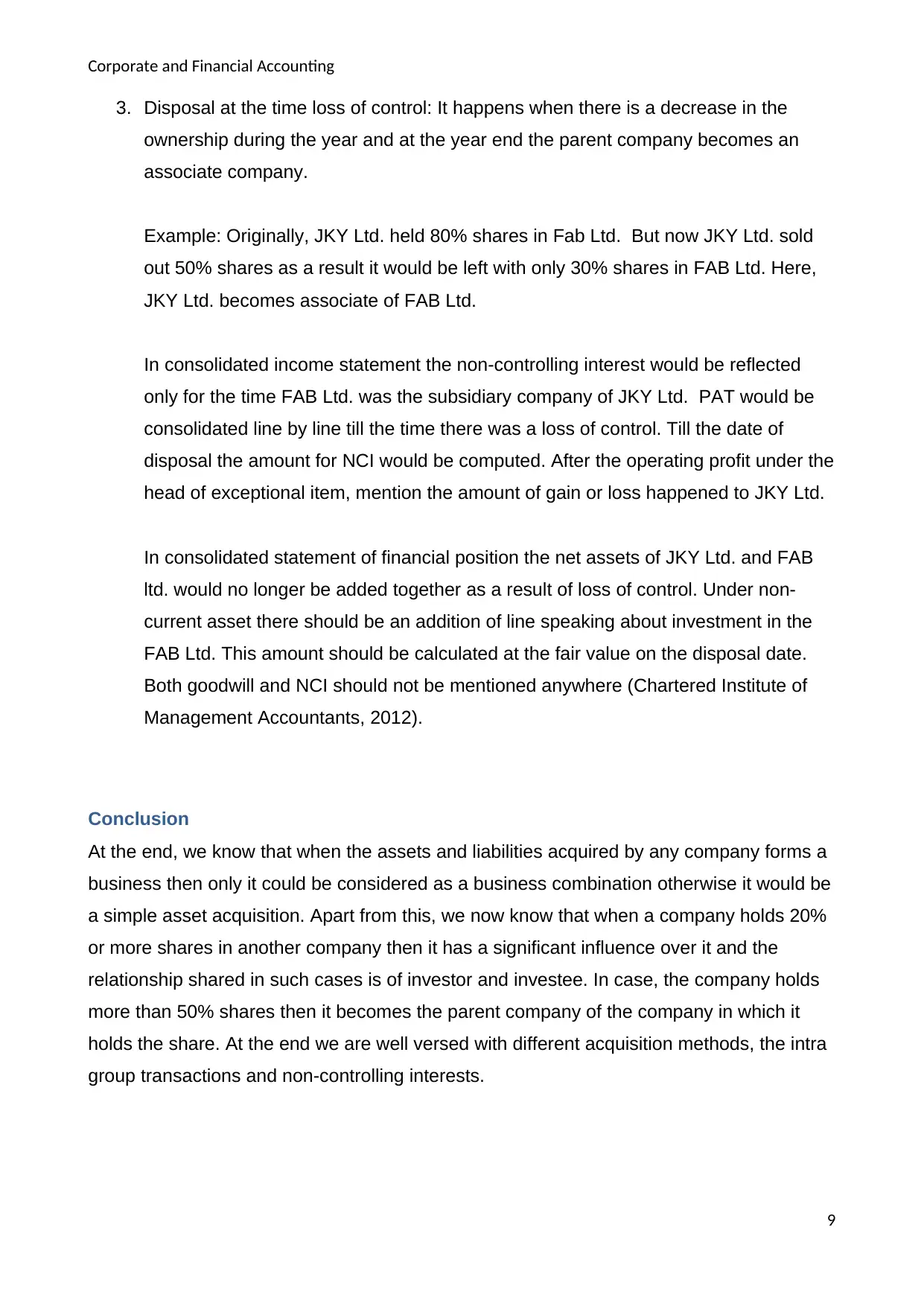
Corporate and Financial Accounting
3. Disposal at the time loss of control: It happens when there is a decrease in the
ownership during the year and at the year end the parent company becomes an
associate company.
Example: Originally, JKY Ltd. held 80% shares in Fab Ltd. But now JKY Ltd. sold
out 50% shares as a result it would be left with only 30% shares in FAB Ltd. Here,
JKY Ltd. becomes associate of FAB Ltd.
In consolidated income statement the non-controlling interest would be reflected
only for the time FAB Ltd. was the subsidiary company of JKY Ltd. PAT would be
consolidated line by line till the time there was a loss of control. Till the date of
disposal the amount for NCI would be computed. After the operating profit under the
head of exceptional item, mention the amount of gain or loss happened to JKY Ltd.
In consolidated statement of financial position the net assets of JKY Ltd. and FAB
ltd. would no longer be added together as a result of loss of control. Under non-
current asset there should be an addition of line speaking about investment in the
FAB Ltd. This amount should be calculated at the fair value on the disposal date.
Both goodwill and NCI should not be mentioned anywhere (Chartered Institute of
Management Accountants, 2012).
Conclusion
At the end, we know that when the assets and liabilities acquired by any company forms a
business then only it could be considered as a business combination otherwise it would be
a simple asset acquisition. Apart from this, we now know that when a company holds 20%
or more shares in another company then it has a significant influence over it and the
relationship shared in such cases is of investor and investee. In case, the company holds
more than 50% shares then it becomes the parent company of the company in which it
holds the share. At the end we are well versed with different acquisition methods, the intra
group transactions and non-controlling interests.
9
3. Disposal at the time loss of control: It happens when there is a decrease in the
ownership during the year and at the year end the parent company becomes an
associate company.
Example: Originally, JKY Ltd. held 80% shares in Fab Ltd. But now JKY Ltd. sold
out 50% shares as a result it would be left with only 30% shares in FAB Ltd. Here,
JKY Ltd. becomes associate of FAB Ltd.
In consolidated income statement the non-controlling interest would be reflected
only for the time FAB Ltd. was the subsidiary company of JKY Ltd. PAT would be
consolidated line by line till the time there was a loss of control. Till the date of
disposal the amount for NCI would be computed. After the operating profit under the
head of exceptional item, mention the amount of gain or loss happened to JKY Ltd.
In consolidated statement of financial position the net assets of JKY Ltd. and FAB
ltd. would no longer be added together as a result of loss of control. Under non-
current asset there should be an addition of line speaking about investment in the
FAB Ltd. This amount should be calculated at the fair value on the disposal date.
Both goodwill and NCI should not be mentioned anywhere (Chartered Institute of
Management Accountants, 2012).
Conclusion
At the end, we know that when the assets and liabilities acquired by any company forms a
business then only it could be considered as a business combination otherwise it would be
a simple asset acquisition. Apart from this, we now know that when a company holds 20%
or more shares in another company then it has a significant influence over it and the
relationship shared in such cases is of investor and investee. In case, the company holds
more than 50% shares then it becomes the parent company of the company in which it
holds the share. At the end we are well versed with different acquisition methods, the intra
group transactions and non-controlling interests.
9
Paraphrase This Document
Need a fresh take? Get an instant paraphrase of this document with our AI Paraphraser

Corporate and Financial Accounting
References
AASB 3.(2015). Business Combinations. Available 30 May, 2019
https://www.aasb.gov.au/admin/file/content105/c9/AASB3_08-15.pdf.
AASB 10.(2011). Consolidated Financial Statements. Available 30 May, 2019
https://www.aasb.gov.au/admin/file/content105/c9/AASB10_08-11.pdf.
AASB 101.(2015). Presentation of Financial Statements. Available 30 May, 2019
https://www.aasb.gov.au/admin/file/content105/c9/AASB101_07-15.pdf.
AASB 127.(2011). Consolidated and Separate Financial Statements. Available 30 May,
2019 https://www.aasb.gov.au/admin/file/content105/c9/AASB127_03-08_COMPjul11_07-
11.pdf.
AASB 128.(2016). Investments in Associates and Joint Ventures. Available 30 May, 2019
https://www.aasb.gov.au/admin/file/content105/c9/AASB128_08-15_COMPdec15_01-
18.pdf.
Chartered Institute of Management Accountants.(2012). Principles of Management
Accounting. Available 30 May, 2019 http://www.cimaglobal.com/Pages-that-we-will-need-
to-bring-back/velocity-archive/Velocity-e-magazine/Velocity-2012/Velocity-April-2012/
Principles-of-group-accounting-F2-by-Jayne-Howson/.
So, S., Wong, K.S., Zhang, F. And Zhang, X. (2018).Value Relevance of proportionate
consolidation versus the equity method: Evidence from Hong Kong. China Journal of
Accounting Research.[Online]. 11(4), p. 255-278. Available 30 May, 2019
https://www.sciencedirect.com/science/article/pii/S1755309118301321
10
References
AASB 3.(2015). Business Combinations. Available 30 May, 2019
https://www.aasb.gov.au/admin/file/content105/c9/AASB3_08-15.pdf.
AASB 10.(2011). Consolidated Financial Statements. Available 30 May, 2019
https://www.aasb.gov.au/admin/file/content105/c9/AASB10_08-11.pdf.
AASB 101.(2015). Presentation of Financial Statements. Available 30 May, 2019
https://www.aasb.gov.au/admin/file/content105/c9/AASB101_07-15.pdf.
AASB 127.(2011). Consolidated and Separate Financial Statements. Available 30 May,
2019 https://www.aasb.gov.au/admin/file/content105/c9/AASB127_03-08_COMPjul11_07-
11.pdf.
AASB 128.(2016). Investments in Associates and Joint Ventures. Available 30 May, 2019
https://www.aasb.gov.au/admin/file/content105/c9/AASB128_08-15_COMPdec15_01-
18.pdf.
Chartered Institute of Management Accountants.(2012). Principles of Management
Accounting. Available 30 May, 2019 http://www.cimaglobal.com/Pages-that-we-will-need-
to-bring-back/velocity-archive/Velocity-e-magazine/Velocity-2012/Velocity-April-2012/
Principles-of-group-accounting-F2-by-Jayne-Howson/.
So, S., Wong, K.S., Zhang, F. And Zhang, X. (2018).Value Relevance of proportionate
consolidation versus the equity method: Evidence from Hong Kong. China Journal of
Accounting Research.[Online]. 11(4), p. 255-278. Available 30 May, 2019
https://www.sciencedirect.com/science/article/pii/S1755309118301321
10
1 out of 11
Related Documents
Your All-in-One AI-Powered Toolkit for Academic Success.
+13062052269
info@desklib.com
Available 24*7 on WhatsApp / Email
![[object Object]](/_next/static/media/star-bottom.7253800d.svg)
Unlock your academic potential
Copyright © 2020–2026 A2Z Services. All Rights Reserved. Developed and managed by ZUCOL.





